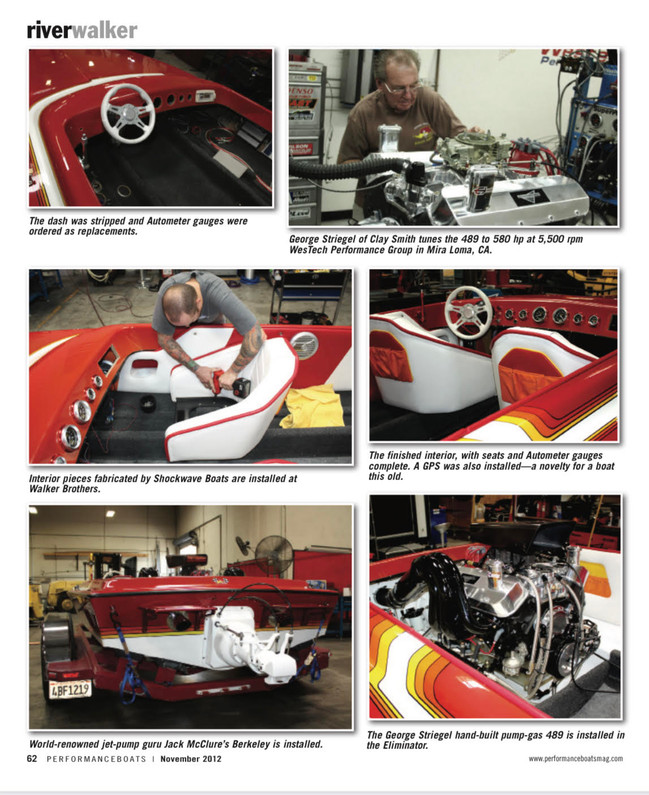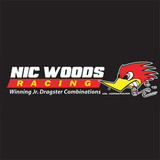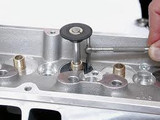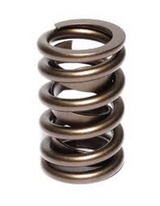Performance Boats 2012 Article: River Walker
A third generation of Walker family rocks the Colorado River in style, thanks to an all-star cast of old-school performance studs.
by Kevin Spaise
There is likely a little bit of the Colorado River flowing through the veins of the Walker Family, as much as it has been a part of their lives—and so it seems only fitting that the impressive revival of this classic ’89 Eliminator 19' bubbledeck jet boat rallied an all-star cast of players whose own destinies flowed for decades on that same river. Company Jet captures the essence of hardcore river boating from every angle, beginning with the fiberglass foundation, a hull that immediately became Eliminator’s best-selling river boat upon its release. Eliminator bubbledeck, big block Chevy, Berkeley jet— the combination rocked The River in its day, and turns as many heads today. Eliminator makes no claim to inventing the bubbledeck, but they lit the fuse as it blew up all over the Colorado River in the late1980s, and like nearly all of Bob Leach’s pet releases, the design remains timeless. The Walker ride looks as at home on the shoreline today as it did nearly 25 years ago. The appeal is more than evident following the best efforts of the hand-picked assemblage of contributors to Walker’s project, a celebration of their family’s third generation of hard core river boating. The boat was built and looks very much like the ideal machine for the emerging members of Curtis’s hot-boating family, Jordan (15), Hunter (17), and Shane (19). As with every great river boat, this one had to be perfectly matched to the priority of its users, and that’s where George Striegel and his Clay Smith Engineering team came into play.
“The kids are tubing and hot-rodding all day long, with five kids in the boat,” says Curtis.” They have a couple of standup Skis, and strap the tube to the top, and they’re off for the day. When they run out of gas 30 gallons later, they’re back for more fuel. But they know how to run the river—they’ve grown up around it, and they’re responsible boaters.” All of that adds up to a relatively conservative build where Striegel is concerned, compared, for example, to Curtis’s own 21' Ultra bowrider, which runs a Clay Smith blown 540-incher and builds 800 HP with a Westech Performance Group dyno pedigree. George Striegel and his pack approached this one the same way they do every one of a steady flow of engine build-ups: with the best parts to be found in America, old-school technology that has proven solid for decades, and solid follow-through on every detail. Clay Smith’s build sheet on the boat calls for cast iron heads and single carburetion, and a setup that drinks freely of 91-octane pump gas with no ill effects.
“As far as I’m concerned,” says Walker, “George Striegel might as well walk on water. I think he has the whole horsepower and jet thing figured out pretty well.” Striegel’s multitude of championships, mostly earned not only behind his engines but also his driving prowess, offer supporting evidence. Curtis found the Eliminator on a desperate hunt with a river trip at hand, and the Ultra in the shop for some due and necessary maintenance. He figured it was about time to give the kids a little more freedom anyway, a move that has done little to sway the family from the passion shared by their father and late grandfather, Ken Walker. Curtis was twelve when he started driving the family Hornet, which ran a 360/Panther package. There was always a family motor home in the picture, and much of the time it was pointed toward or away from The River, Havasu, Shasta, or some other hot-boating venue. He and his older brother (by two years), Dave, filled many a summer day running up and down the river. After the Hornet, the family ran an Eliminator 21 Monaco Bowrider with a Volvo/350 setup. That Eliminator experience played large in Curtis’s decision to buy this one. With the Ultra in the shop, and a big river trip looming, Mike found the Eliminator in the classifieds, and got his money’s worth at five grand, for a running classic. Though it was purchased as a second boat, the family immediately set about to make the thing right and do things the right way, another tradition runs deep— and which has paid dividends in the family business.
Dave and Curtis didn’t just start boating early—they were also early entrepreneurs. Their father sold heavy machinery, and the pre-teen boys earned extra money moving sold machinery around in preparation for customer pickup. When Curtis was 15 and Dave 17, they saved their cash and drove to Phoenix to buy their first trailer. Walker Brothers Machinery now has a fleet of some 35 trucks, and is the biggest in the business. Business became serious, and boating remained fun. “We were really just two kids who needed money to go to The River, and just figured it out,” Curtis says. Curtis and the family and friends hit the river every other weekend faithfully from April until October, and selectively in the winter. The brothers graduated to a bigger boat, a 36' Grady White blue water machine, but their low-pro roots run deep. They still tube and ski behind Curtis’s 540" powered Ultra, which purrs nice and mellow for as long as he likes while tubing and skiing, and sets its passengers deep in their seats when the sun starts to go down and the guns come to run. The 800-horse Clay Smith mows through 6,400 rpm and runs 91 octane. Just as with the Eliminator project, one of Walker’s first stops was at Jack McClure’s shop, where the Ultra picked up a total jet hardware and pump blueprinting makeover. The kids’ Eliminator also received nothing less than the River All-Star treatment, but only after Walker and some of the guys at his shop, most notably Chris Rossi and Mike San Pedro, fine-tuned the foundation a bit. They gutted the Eliminator, removing all of the worn hardware and replacing most of it with gleaming finery from the talented artisans at Dana Marine. They replaced leaky headers with fresh Bassetts and repaired 20-odd years of dock dings, ski scratches, and the other inevitable gelcoat blems brought on by a well-used river boat. They opted to leave the gelcoat original, again honoring the familiar old school in which they received their hot boating education. Along that same line, the rub railing was freshly black-anodized (Dooley Enterprises fit the engine with a new 10-quart pan, and fabricated one of their patented, custom scoops—a fitting dash of functional style to a boat that throws off a powerful old-school strut with a thinly veiled dose of contemporary flash. ) tunes the 489 to 580 hp at 5,500 rpm WesTech Performance Group in Mira Loma, CA.
After conferring with Curtis, George Striegel decided to build a conservative pump-gas 454-stroker engine with 489 cubic inches, bored 30 over and with a quarter inch of stroke. Since George always builds engines with longevity in mind, a flat tappet Clay Smith camshaft (part number C-306-8-B) was installed, and a low com - pression of 489 was selected. A factory 990 steel rectangular head was chosen for peak reliability and performance.
The setup also includes:
• Forged JE pistons
• Callies Dragonslayer crankshaft
• H-beam Manley rods with ARP 2000 bolts
• Manley valves
• Inconel exhaust
• Stainless intake
• McGurk/Isky roller rockers
• 3/8 Clay Smith one-piece pushrods (.083 wall)
In addition, Striegel opted for a dualplane Edelbrock manifold for peak torque and hp performance under 6,000 rpm. During the buildup, Walker contributed a Holley 850 double pumper carb, but it had a flaw in the rear metering block. Fortunately, Steve Brule at WesTech provided a new Holley 950 HP series carburetor, which performed flawlessly. On the dyno, the completed engine made 580 hp at 5,500 rpm and 570 ft./lbs. of torque at 3,500 rpm.,
Dana Marine fabricated the battery boxes, provided the AutoMeter gauges, controls and billet swim steps, which play a huge role in the family weekends.
Striegel turned to the old jet boat warrior and mega-champion, Jack McClure, who has forgotten more than nearly everyone in jet boating, has ever known about pump work. McClure rallied around the project and rebuilt the original Berkeley, refining the setup to the power curve and task at hand. Again, the family’s priorities—running hard all day long without a problem, keeping things smooth at 3,000 rpm, and laying down a hot pass or two on command, stayed top of mind. He installed and reset one of his intake grates, and fit the pump with a stainless shaft, impeller, and inducer. He blueprinted the bowl, and added a droop snoot and a four-degree wedge. Along the way, he replaced a broken skeg.
The Place boys rebuilt the original manual Place Diverter.
Shockwave Boats took on the task of styling the interior, lending a slightly more contemporary tone to the upholstery without disrupting the overall feel of the era. They built future life into the boat, adding reinforcement to the transom, rebuilding the bulkhead supports, and replacing the rotting seat wood with new lumber. Shockwave finished off the look with new carpeting, and the interior smacks of the same award-winning work that graces Shockwave’s new build-outs. “We got to know George pretty well—we all boat at the same spot at the river, and he got a great sense of how we boat and what we needed before he built the engine,” says Walker. “With George and Patty, there is a lot of wisdom in what they do—it’s the old school approach, and it works. You turn the key, and the boat starts, every time. No funny noises, it just runs and runs, wide open at the river, all day until it gets dark.
Recent Posts
-
Nic Woods Racing, now brought to you by Clay Smith Engineering
Established in 2012, Nic Woods Racing began as an extension of owner Nic Woods' JDRL and Outlaw 330 …11th Aug 2025 -
How to Check Installed Height
Install the valve in the guide. Install the retainer and valve locks. Install all spring cups and/o …10th Jan 2025 -
The Importance of Valve Spring Coil Clearance to prevent Coil Bind
Coil bind is when the valve spring is compressed fully to the point that all of the coils are "stack …10th Jan 2025





